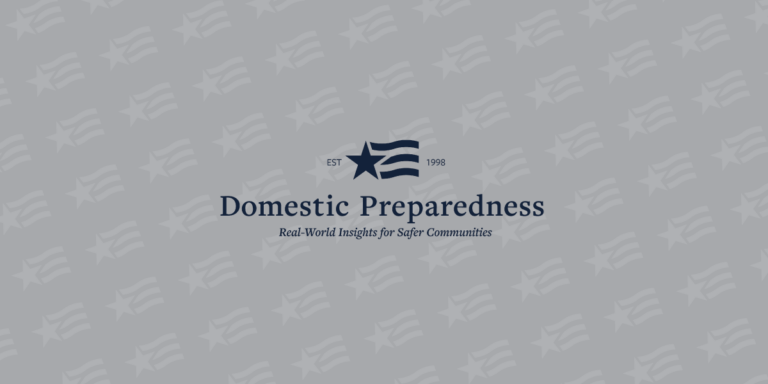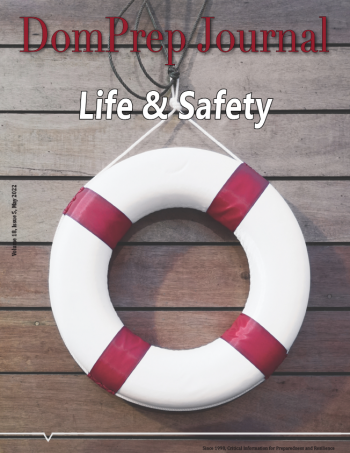
Author Archive

FEMA/DHS/USFA developed the “Wildland Urban Interface: A Look at Issues and Resolutions” to stimulate action by raising awareness of the crisis that our nation faces related to wildfire in the wildland urban interface

Statement from HHS Secretary Becerra on the CDC Decision to Rescind the Order Requiring Pre-Departure COVID-19 Testing Prior to Flight to the U.S.
Domestic Preparedness
June 13, 2022
U.S. Department of Health and Human Services Secretary Xavier Becerra issued a statement after the Centers for Disease Control and Prevention announced that – based on science and available data – pre-departure COVID-19 testing for U.S.-bound air travelers will no longer be required

DHS S&T Helps Keep Communities Safe from Chemical Hazards During Hurricane Season
Domestic Preparedness
June 6, 2022
Extreme weather from hurricanes and tropical storms can devastate communities along the Atlantic, Gulf and Pacific coasts, and the threat of subsequent hazard chemical releases can be just as deadly. The Department of Homeland Security (DHS) Science and Technology Directorate (S&T) actively anticipates and prepares for this possibility.

IHS Allocates $700 Million From President Biden’s Bipartisan Infrastructure Law to Improve Tribal Water and Sanitation Systems
Domestic Preparedness
June 6, 2022
The funding allocation will provide 71,000 American Indian and Alaska Native homes with critical services like water wells and onsite wastewater disposal systems and connections to community water supply and wastewater disposal systems.

HHS Leaders Urge States to Maximize Efforts to Support Children’s Mental Health
Domestic Preparedness
May 27, 2022
Agencies across the U.S. Department of Health and Human Services (HHS) issued a joint letter to states, tribes, and jurisdictions encouraging them to prioritize and maximize their efforts to strengthen children’s mental health and well-being.

May 2022
Domestic Preparedness
May 25, 2022
Featured in this issue: Editor Note: Protecting Life and Safety – A Job for Everyone, by Catherine L. Feinman; Project Management Approach in Emergency Management, by Adam Tager; Suburban Fire Operations: Five Lessons Learned, by Randall W. Hanifen; Stop the Bleed Training for Immediate Responders, byAndy Altizer; Crowd Behavior &

EMS Safety Practices
Domestic Preparedness
May 20, 2022
This report provides tools to support and strengthen fire and emergency medical services and stakeholders to prepare for, prevent, mitigate and respond to all hazards.

DHS Announces $1.6 Billion in Preparedness Grants
Domestic Preparedness
May 16, 2022
Secretary of Homeland Security Alejandro N. Mayorkas today announced $1.6 billion for eight Fiscal Year 2022 preparedness grant programs. Together, these programs provide critical funding to help state and local officials prepare for, prevent, protect against, and respond to acts of terrorism and other hazards.

Unique binding of Delta variant may explain high transmissibility
Domestic Preparedness
May 13, 2022
Unlike other SARS-CoV-2 variants, the Delta variant can attach to copies of itself, forming larger aggregations, or clumps, of viral particles, suggests a study by scientists at the National Institutes of Health. The researchers theorize that this linking property may have played a role in the ability of the Delta

Collaborative Reform Initiative
Domestic Preparedness
May 6, 2022
The 2022 Collaborative Reform Initiative encompasses three technical assistance programs offering expert services to state, local, territorial, and tribal law enforcement agencies to support effective community policing. This continuum of services is designed to build trust between law enforcement agencies and the communities they serve; improve operational efficiencies and effectiveness;
Follow Us
Get Instant Access
Subscribe today to Domestic Preparedness and get real-world insights for safer communities.
ARchives
Article Out Loud – Unleashing Community Resilience Through Collaborative Leadership
January 31, 2024
Full Article By Michael R. Valiente, an Article Out Loud from Domestic Preparedness, January 31, 2024. Elected officials and emergency response personnel form the nucleus of community leadership, a driving force for collaborative relationships with local stakeholders. Find out how community leaders who adopt the tenets of transformational leaders can
Article Out Loud – Commercial Facilities Sector Perspectives
January 31, 2024
Full Article By Kole (KC) Campbell, an Article Out Loud from Domestic Preparedness, January 31, 2024. Commercial facilities dominate the U.S. economy, contributing trillions of dollars to the U.S. gross domestic product while employing and supporting millions of jobs. Learn more about this critical infrastructure sector and its interdependencies. Listen
Article Out Loud – Weathering the Unknown: Inside Grant County Emergency Management
January 24, 2024
Full Article By Tara Goode, an Article Out Loud from Domestic Preparedness, January 24, 2024.When threatening weather approaches, communities must make tough decisions. Grant County, Minnesota, is building on its lessons learned to better prepare for future severe storms. Listen on
Article Out Loud – Rising Above the Flood: A Decision Tool for Structural Safety
January 24, 2024
Full Article By Cedric Ling, Debashish Kar, Nur Yazdani, Eyosias Beneberu, Maria Koliou, and Yong Yoo, an Article Out Loud from Domestic Preparedness, January 24, 2024. When homeowners choose to elevate their homes above flood levels, they may compromise the structural integrity of the building if the elevation method does
Article Out Loud – Beyond Patient Care: Family Reunification Planning for Hospitals
January 17, 2024
Full Article By Michael Prasad, An Article Out Loud from Domestic Preparedness, January 17, 2024. To meet a community’s mass care family reunification needs after a disaster, hospitals and other healthcare facilities must have plans and procedures in place for mass casualty incident response, which goes beyond patient care. Here
Article Out Loud – Multimodal Transportation Perspectives
January 17, 2024
Full Article By Nathan DiPillo and Derek Kantar, An Article Out Loud from Domestic Preparedness, January 17, 2024.Without transportation and communications, emergency response can move at an uncomfortably slow pace, enough so that life, property, and the environment may be unnecessarily compromised. The integrated transportation network must be protected from
Article Out Loud – Resilience Versus Emergency Management
January 10, 2024
By Wayne P. Bergeron, An Article Out Loud from Domestic Preparedness, January 10, 2024.Conferences are full of important and interesting sessions, but attendees do not always take away actionable knowledge or have long-term retention of the information. This article summarizes a crowd-sourced conversation with panelists, attendees, resilience experts, and Chat
Article Out Loud – Energy Sector Perspectives
January 10, 2024
By Eric Easton, An Article Out Loud from Domestic Preparedness, January 10, 2024. From the alarm clock that wakes people in the morning, to the natural gas used to cook breakfast, to the refined petroleum products powering vehicles for daily commutes, the Energy Sector plays an integral role in daily
Article Out Loud – The Need for Community Public Safety UAS Programs
November 21, 2023
Despite ongoing efforts to protect communities against attacks involving transportation, buildings, historic sites, sporting events, and so on, this 2018 uncrewed aerial system (UAS) checklist is still applicable today.
Article Out Loud – Five Steps Toward Enhancing Climate Resilience
November 21, 2023
Many communities have been impacted by “acute climate shocks” such as wildfires, hurricanes, floods, heatwaves, and severe winter storms – resulting in the loss of lives, livelihoods, and infrastructure. The five steps shared in this 2018 article can help enhance climate resilience.
Follow Us
Get Instant Access
Subscribe today to Domestic Preparedness and get real-world insights for safer communities.


